Business Law: Sale of Goods Act and Supply of Goods and Services Act
VerifiedAdded on 2023/03/31
|16
|4687
|437
AI Summary
This report focuses on the Sale of Goods Act 1979 and Supply of Goods and Services Act 1982 in business law. It covers topics such as implied terms, transfer of property and possession, buyer's and seller's remedies, and product liability of faulty goods. The report also discusses types of credit agreements for buying a car and the legal rules on termination of rights and default notices for customers. Additionally, it explains the general features of agency and differentiates between types of agents.
Contribute Materials
Your contribution can guide someone’s learning journey. Share your
documents today.
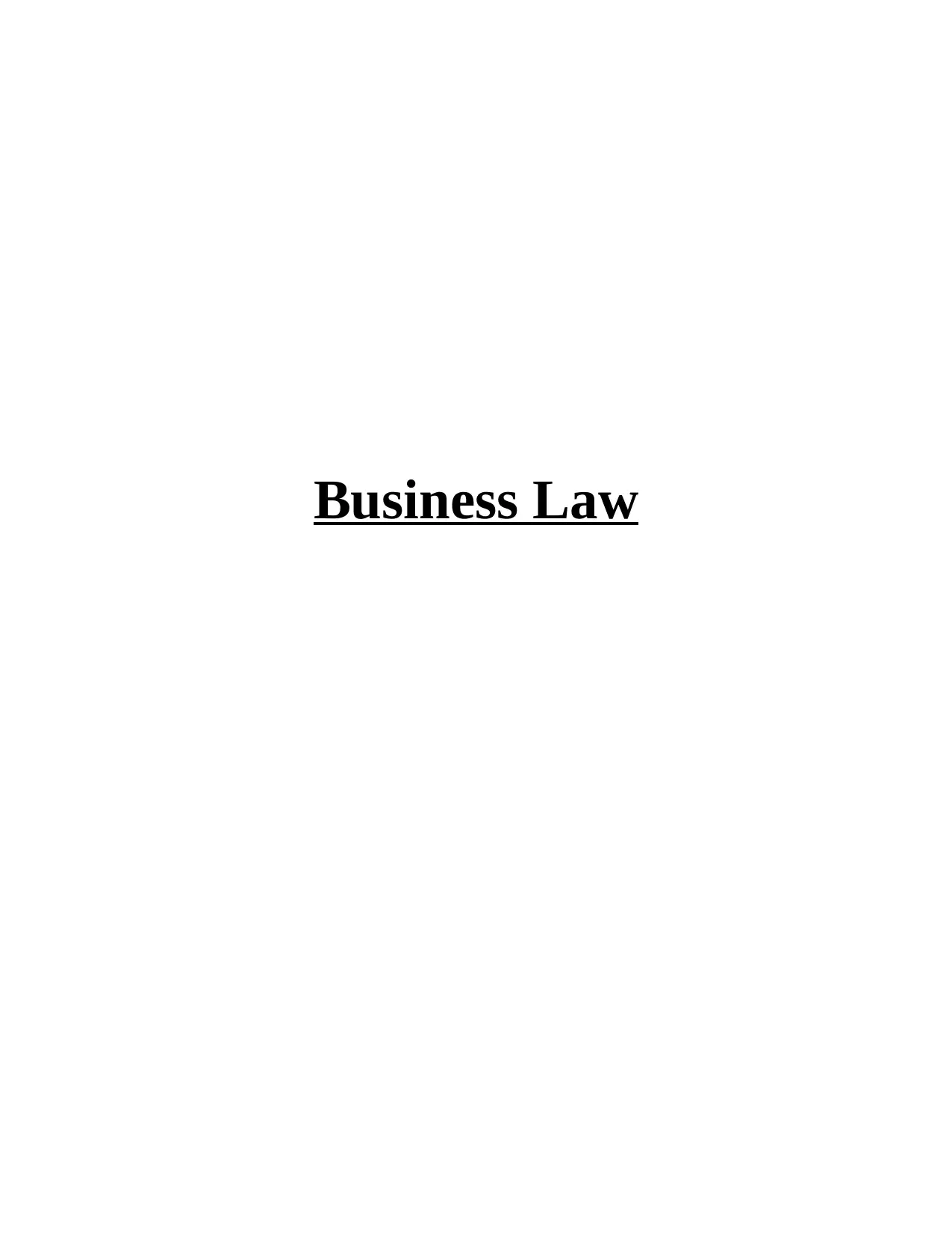
Business Law
Secure Best Marks with AI Grader
Need help grading? Try our AI Grader for instant feedback on your assignments.
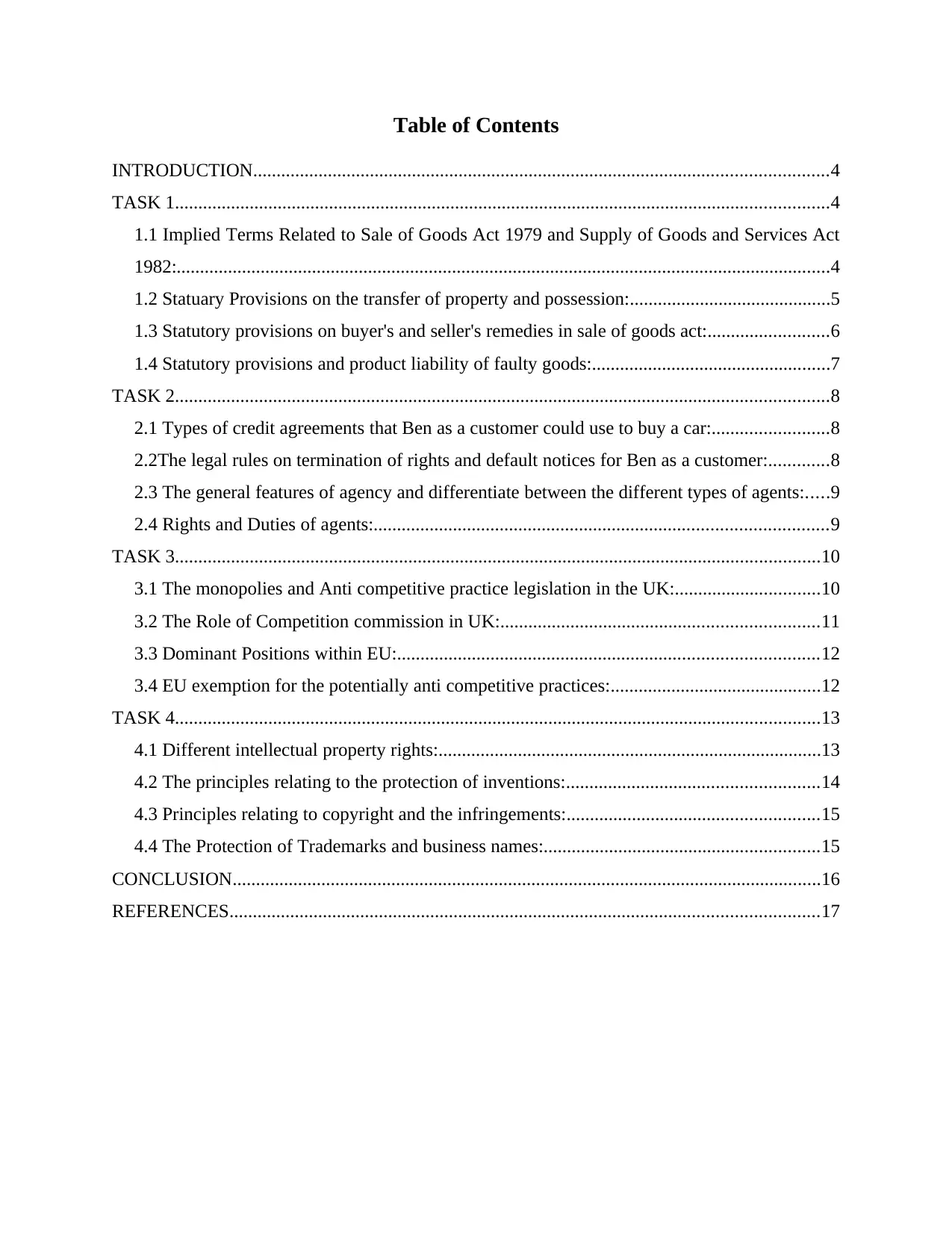
Table of Contents
INTRODUCTION...........................................................................................................................4
TASK 1............................................................................................................................................4
1.1 Implied Terms Related to Sale of Goods Act 1979 and Supply of Goods and Services Act
1982:............................................................................................................................................4
1.2 Statuary Provisions on the transfer of property and possession:...........................................5
1.3 Statutory provisions on buyer's and seller's remedies in sale of goods act:..........................6
1.4 Statutory provisions and product liability of faulty goods:...................................................7
TASK 2............................................................................................................................................8
2.1 Types of credit agreements that Ben as a customer could use to buy a car:.........................8
2.2The legal rules on termination of rights and default notices for Ben as a customer:.............8
2.3 The general features of agency and differentiate between the different types of agents:.....9
2.4 Rights and Duties of agents:.................................................................................................9
TASK 3..........................................................................................................................................10
3.1 The monopolies and Anti competitive practice legislation in the UK:...............................10
3.2 The Role of Competition commission in UK:....................................................................11
3.3 Dominant Positions within EU:..........................................................................................12
3.4 EU exemption for the potentially anti competitive practices:.............................................12
TASK 4..........................................................................................................................................13
4.1 Different intellectual property rights:..................................................................................13
4.2 The principles relating to the protection of inventions:......................................................14
4.3 Principles relating to copyright and the infringements:......................................................15
4.4 The Protection of Trademarks and business names:...........................................................15
CONCLUSION..............................................................................................................................16
REFERENCES..............................................................................................................................17
INTRODUCTION...........................................................................................................................4
TASK 1............................................................................................................................................4
1.1 Implied Terms Related to Sale of Goods Act 1979 and Supply of Goods and Services Act
1982:............................................................................................................................................4
1.2 Statuary Provisions on the transfer of property and possession:...........................................5
1.3 Statutory provisions on buyer's and seller's remedies in sale of goods act:..........................6
1.4 Statutory provisions and product liability of faulty goods:...................................................7
TASK 2............................................................................................................................................8
2.1 Types of credit agreements that Ben as a customer could use to buy a car:.........................8
2.2The legal rules on termination of rights and default notices for Ben as a customer:.............8
2.3 The general features of agency and differentiate between the different types of agents:.....9
2.4 Rights and Duties of agents:.................................................................................................9
TASK 3..........................................................................................................................................10
3.1 The monopolies and Anti competitive practice legislation in the UK:...............................10
3.2 The Role of Competition commission in UK:....................................................................11
3.3 Dominant Positions within EU:..........................................................................................12
3.4 EU exemption for the potentially anti competitive practices:.............................................12
TASK 4..........................................................................................................................................13
4.1 Different intellectual property rights:..................................................................................13
4.2 The principles relating to the protection of inventions:......................................................14
4.3 Principles relating to copyright and the infringements:......................................................15
4.4 The Protection of Trademarks and business names:...........................................................15
CONCLUSION..............................................................................................................................16
REFERENCES..............................................................................................................................17
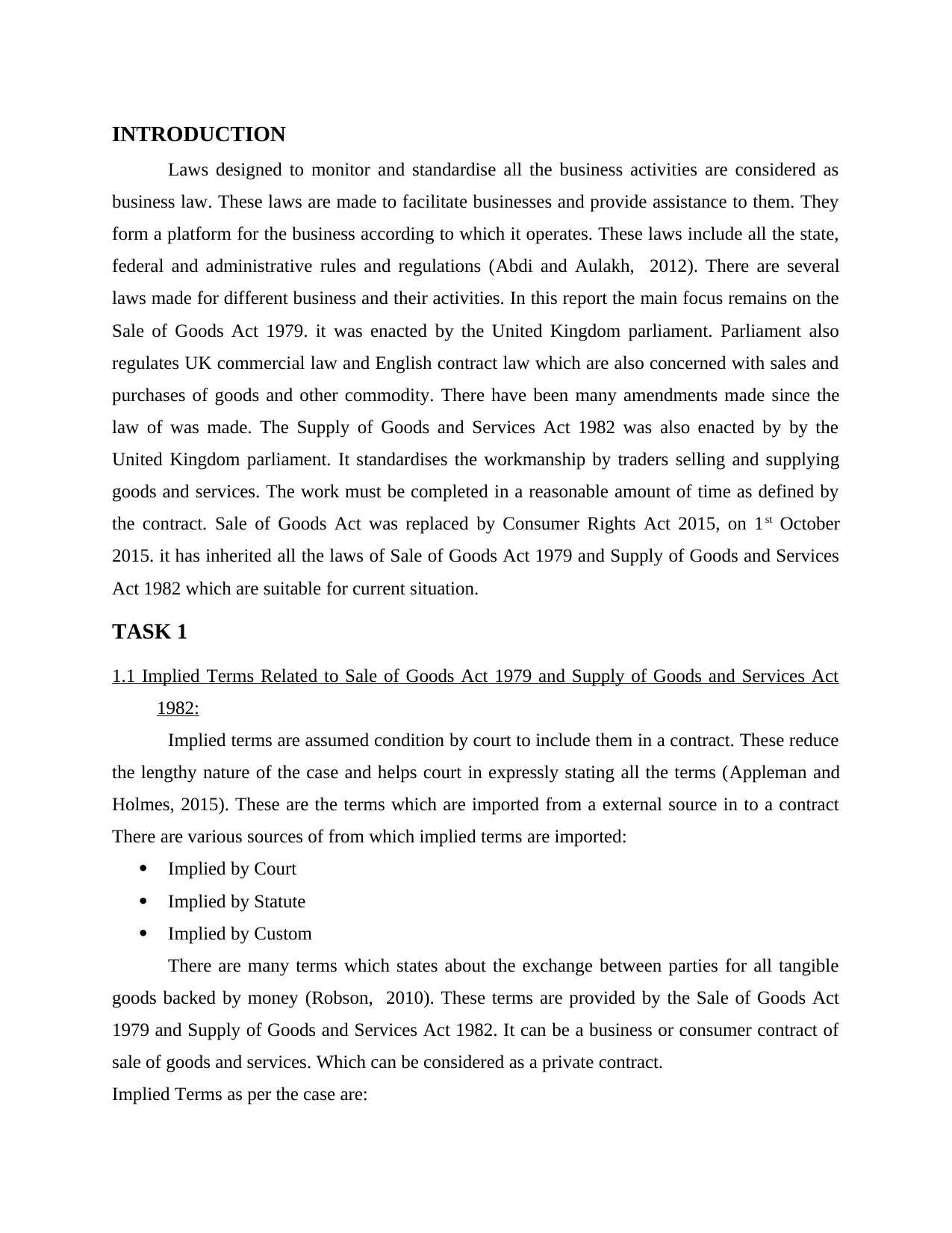
INTRODUCTION
Laws designed to monitor and standardise all the business activities are considered as
business law. These laws are made to facilitate businesses and provide assistance to them. They
form a platform for the business according to which it operates. These laws include all the state,
federal and administrative rules and regulations (Abdi and Aulakh, 2012). There are several
laws made for different business and their activities. In this report the main focus remains on the
Sale of Goods Act 1979. it was enacted by the United Kingdom parliament. Parliament also
regulates UK commercial law and English contract law which are also concerned with sales and
purchases of goods and other commodity. There have been many amendments made since the
law of was made. The Supply of Goods and Services Act 1982 was also enacted by by the
United Kingdom parliament. It standardises the workmanship by traders selling and supplying
goods and services. The work must be completed in a reasonable amount of time as defined by
the contract. Sale of Goods Act was replaced by Consumer Rights Act 2015, on 1st October
2015. it has inherited all the laws of Sale of Goods Act 1979 and Supply of Goods and Services
Act 1982 which are suitable for current situation.
TASK 1
1.1 Implied Terms Related to Sale of Goods Act 1979 and Supply of Goods and Services Act
1982:
Implied terms are assumed condition by court to include them in a contract. These reduce
the lengthy nature of the case and helps court in expressly stating all the terms (Appleman and
Holmes, 2015). These are the terms which are imported from a external source in to a contract
There are various sources of from which implied terms are imported:
Implied by Court
Implied by Statute
Implied by Custom
There are many terms which states about the exchange between parties for all tangible
goods backed by money (Robson, 2010). These terms are provided by the Sale of Goods Act
1979 and Supply of Goods and Services Act 1982. It can be a business or consumer contract of
sale of goods and services. Which can be considered as a private contract.
Implied Terms as per the case are:
Laws designed to monitor and standardise all the business activities are considered as
business law. These laws are made to facilitate businesses and provide assistance to them. They
form a platform for the business according to which it operates. These laws include all the state,
federal and administrative rules and regulations (Abdi and Aulakh, 2012). There are several
laws made for different business and their activities. In this report the main focus remains on the
Sale of Goods Act 1979. it was enacted by the United Kingdom parliament. Parliament also
regulates UK commercial law and English contract law which are also concerned with sales and
purchases of goods and other commodity. There have been many amendments made since the
law of was made. The Supply of Goods and Services Act 1982 was also enacted by by the
United Kingdom parliament. It standardises the workmanship by traders selling and supplying
goods and services. The work must be completed in a reasonable amount of time as defined by
the contract. Sale of Goods Act was replaced by Consumer Rights Act 2015, on 1st October
2015. it has inherited all the laws of Sale of Goods Act 1979 and Supply of Goods and Services
Act 1982 which are suitable for current situation.
TASK 1
1.1 Implied Terms Related to Sale of Goods Act 1979 and Supply of Goods and Services Act
1982:
Implied terms are assumed condition by court to include them in a contract. These reduce
the lengthy nature of the case and helps court in expressly stating all the terms (Appleman and
Holmes, 2015). These are the terms which are imported from a external source in to a contract
There are various sources of from which implied terms are imported:
Implied by Court
Implied by Statute
Implied by Custom
There are many terms which states about the exchange between parties for all tangible
goods backed by money (Robson, 2010). These terms are provided by the Sale of Goods Act
1979 and Supply of Goods and Services Act 1982. It can be a business or consumer contract of
sale of goods and services. Which can be considered as a private contract.
Implied Terms as per the case are:
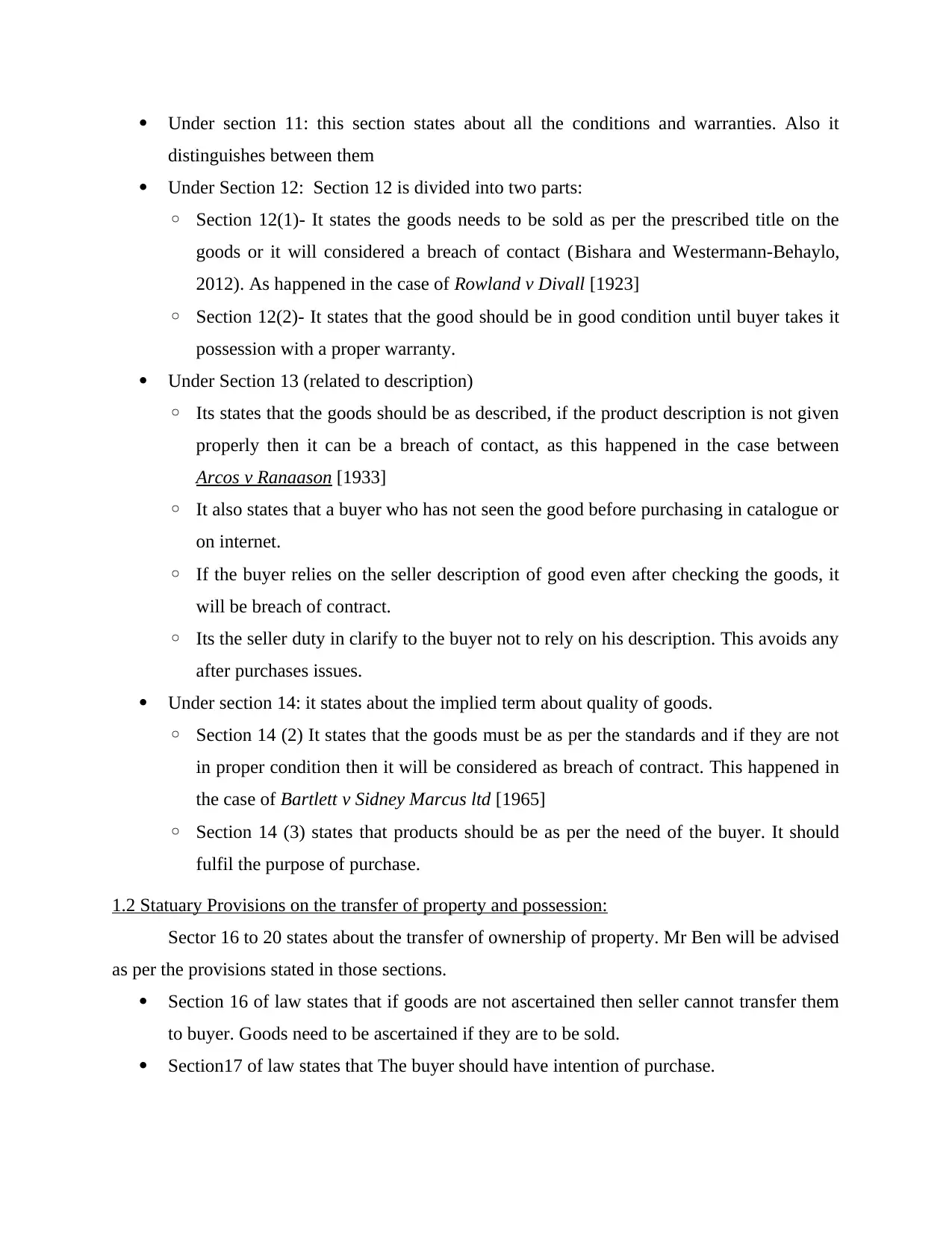
Under section 11: this section states about all the conditions and warranties. Also it
distinguishes between them
Under Section 12: Section 12 is divided into two parts:
◦ Section 12(1)- It states the goods needs to be sold as per the prescribed title on the
goods or it will considered a breach of contact (Bishara and Westermann‐Behaylo,
2012). As happened in the case of Rowland v Divall [1923]
◦ Section 12(2)- It states that the good should be in good condition until buyer takes it
possession with a proper warranty.
Under Section 13 (related to description)
◦ Its states that the goods should be as described, if the product description is not given
properly then it can be a breach of contact, as this happened in the case between
Arcos v Ranaason [1933]
◦ It also states that a buyer who has not seen the good before purchasing in catalogue or
on internet.
◦ If the buyer relies on the seller description of good even after checking the goods, it
will be breach of contract.
◦ Its the seller duty in clarify to the buyer not to rely on his description. This avoids any
after purchases issues.
Under section 14: it states about the implied term about quality of goods.
◦ Section 14 (2) It states that the goods must be as per the standards and if they are not
in proper condition then it will be considered as breach of contract. This happened in
the case of Bartlett v Sidney Marcus ltd [1965]
◦ Section 14 (3) states that products should be as per the need of the buyer. It should
fulfil the purpose of purchase.
1.2 Statuary Provisions on the transfer of property and possession:
Sector 16 to 20 states about the transfer of ownership of property. Mr Ben will be advised
as per the provisions stated in those sections.
Section 16 of law states that if goods are not ascertained then seller cannot transfer them
to buyer. Goods need to be ascertained if they are to be sold.
Section17 of law states that The buyer should have intention of purchase.
distinguishes between them
Under Section 12: Section 12 is divided into two parts:
◦ Section 12(1)- It states the goods needs to be sold as per the prescribed title on the
goods or it will considered a breach of contact (Bishara and Westermann‐Behaylo,
2012). As happened in the case of Rowland v Divall [1923]
◦ Section 12(2)- It states that the good should be in good condition until buyer takes it
possession with a proper warranty.
Under Section 13 (related to description)
◦ Its states that the goods should be as described, if the product description is not given
properly then it can be a breach of contact, as this happened in the case between
Arcos v Ranaason [1933]
◦ It also states that a buyer who has not seen the good before purchasing in catalogue or
on internet.
◦ If the buyer relies on the seller description of good even after checking the goods, it
will be breach of contract.
◦ Its the seller duty in clarify to the buyer not to rely on his description. This avoids any
after purchases issues.
Under section 14: it states about the implied term about quality of goods.
◦ Section 14 (2) It states that the goods must be as per the standards and if they are not
in proper condition then it will be considered as breach of contract. This happened in
the case of Bartlett v Sidney Marcus ltd [1965]
◦ Section 14 (3) states that products should be as per the need of the buyer. It should
fulfil the purpose of purchase.
1.2 Statuary Provisions on the transfer of property and possession:
Sector 16 to 20 states about the transfer of ownership of property. Mr Ben will be advised
as per the provisions stated in those sections.
Section 16 of law states that if goods are not ascertained then seller cannot transfer them
to buyer. Goods need to be ascertained if they are to be sold.
Section17 of law states that The buyer should have intention of purchase.
Secure Best Marks with AI Grader
Need help grading? Try our AI Grader for instant feedback on your assignments.

Section 18 of law states five rules about the transfer of property. These need to be
expressed by the party for proper transfer of property:
◦ Rule 1 states that Contract needs to be unconditional and ascertained for transfer.
◦ Rule 2 states There should be nothing changed in the goods before the transfer of
ownership.
◦ Rule 3 states that goods should be properly measured and checked before they are
transferred.
◦ Rule 4 states that if there is a need of approval for transfer then it should be taken
prior to transfer of ownership.
◦ Rule 5 states that Once goods are ascertained and conditional as per the law they can
be transferred. (this rules has been changed by an amendment in the sale of goods act,
it has now introduced ascertainment by exhaustion and co-ownership.)
Section 19 States about right of disposal of property. If the buyer sells the product even
then seller is entitled with the disposal of goods.
Section 20 states about the risk which is transferred with ownership.
1.3 Statutory provisions on buyer's and seller's remedies in sale of goods act:
There are many statutory provision described by the Sales of Goods Act and Supply of
Goods and Services Act (Bishara, 2011). These provide remedies to both seller and buyer.
Seller remedies as described by the law: From section 41 to 48 are for seller concern, Section 49-
50 deals with personal issues of seller.:
Section 41-43 states about the lien over the property.
Section 44-46 states about the seller capability of stopping a transition of good if buyer
can not pay in return.
Section 47 and 48 states about the rights to sell goods are with seller.
Section 49 states about the action for a certain price
Section 50 states about the situation where buyer refuses to accept goods.
There are certain provision in the case if buyer refuses to accept goods. First is that seller
can hold buyer for the losses and breach of contract. Second, the current prices are taken for
payment of loss.
expressed by the party for proper transfer of property:
◦ Rule 1 states that Contract needs to be unconditional and ascertained for transfer.
◦ Rule 2 states There should be nothing changed in the goods before the transfer of
ownership.
◦ Rule 3 states that goods should be properly measured and checked before they are
transferred.
◦ Rule 4 states that if there is a need of approval for transfer then it should be taken
prior to transfer of ownership.
◦ Rule 5 states that Once goods are ascertained and conditional as per the law they can
be transferred. (this rules has been changed by an amendment in the sale of goods act,
it has now introduced ascertainment by exhaustion and co-ownership.)
Section 19 States about right of disposal of property. If the buyer sells the product even
then seller is entitled with the disposal of goods.
Section 20 states about the risk which is transferred with ownership.
1.3 Statutory provisions on buyer's and seller's remedies in sale of goods act:
There are many statutory provision described by the Sales of Goods Act and Supply of
Goods and Services Act (Bishara, 2011). These provide remedies to both seller and buyer.
Seller remedies as described by the law: From section 41 to 48 are for seller concern, Section 49-
50 deals with personal issues of seller.:
Section 41-43 states about the lien over the property.
Section 44-46 states about the seller capability of stopping a transition of good if buyer
can not pay in return.
Section 47 and 48 states about the rights to sell goods are with seller.
Section 49 states about the action for a certain price
Section 50 states about the situation where buyer refuses to accept goods.
There are certain provision in the case if buyer refuses to accept goods. First is that seller
can hold buyer for the losses and breach of contract. Second, the current prices are taken for
payment of loss.
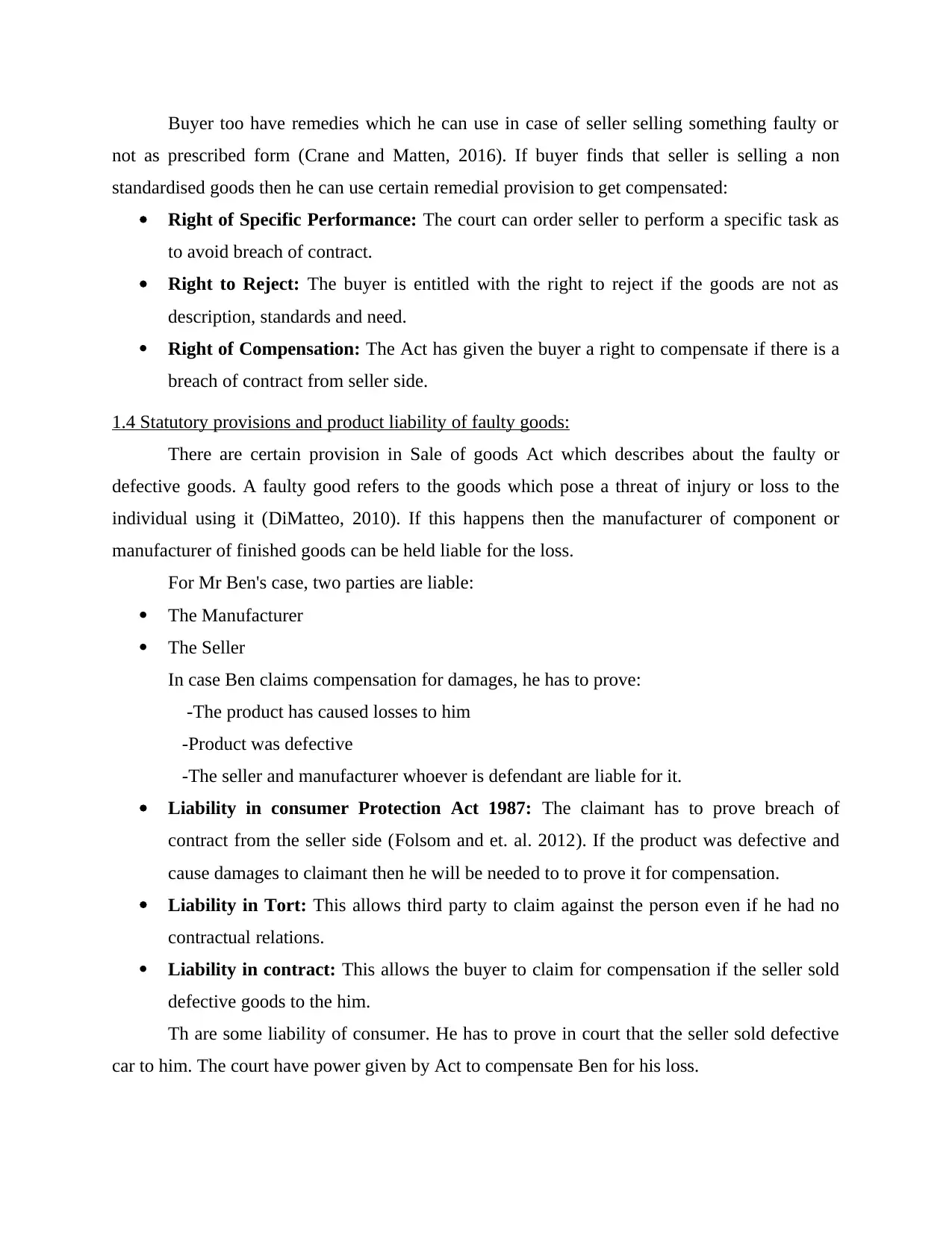
Buyer too have remedies which he can use in case of seller selling something faulty or
not as prescribed form (Crane and Matten, 2016). If buyer finds that seller is selling a non
standardised goods then he can use certain remedial provision to get compensated:
Right of Specific Performance: The court can order seller to perform a specific task as
to avoid breach of contract.
Right to Reject: The buyer is entitled with the right to reject if the goods are not as
description, standards and need.
Right of Compensation: The Act has given the buyer a right to compensate if there is a
breach of contract from seller side.
1.4 Statutory provisions and product liability of faulty goods:
There are certain provision in Sale of goods Act which describes about the faulty or
defective goods. A faulty good refers to the goods which pose a threat of injury or loss to the
individual using it (DiMatteo, 2010). If this happens then the manufacturer of component or
manufacturer of finished goods can be held liable for the loss.
For Mr Ben's case, two parties are liable:
The Manufacturer
The Seller
In case Ben claims compensation for damages, he has to prove:
-The product has caused losses to him
-Product was defective
-The seller and manufacturer whoever is defendant are liable for it.
Liability in consumer Protection Act 1987: The claimant has to prove breach of
contract from the seller side (Folsom and et. al. 2012). If the product was defective and
cause damages to claimant then he will be needed to to prove it for compensation.
Liability in Tort: This allows third party to claim against the person even if he had no
contractual relations.
Liability in contract: This allows the buyer to claim for compensation if the seller sold
defective goods to the him.
Th are some liability of consumer. He has to prove in court that the seller sold defective
car to him. The court have power given by Act to compensate Ben for his loss.
not as prescribed form (Crane and Matten, 2016). If buyer finds that seller is selling a non
standardised goods then he can use certain remedial provision to get compensated:
Right of Specific Performance: The court can order seller to perform a specific task as
to avoid breach of contract.
Right to Reject: The buyer is entitled with the right to reject if the goods are not as
description, standards and need.
Right of Compensation: The Act has given the buyer a right to compensate if there is a
breach of contract from seller side.
1.4 Statutory provisions and product liability of faulty goods:
There are certain provision in Sale of goods Act which describes about the faulty or
defective goods. A faulty good refers to the goods which pose a threat of injury or loss to the
individual using it (DiMatteo, 2010). If this happens then the manufacturer of component or
manufacturer of finished goods can be held liable for the loss.
For Mr Ben's case, two parties are liable:
The Manufacturer
The Seller
In case Ben claims compensation for damages, he has to prove:
-The product has caused losses to him
-Product was defective
-The seller and manufacturer whoever is defendant are liable for it.
Liability in consumer Protection Act 1987: The claimant has to prove breach of
contract from the seller side (Folsom and et. al. 2012). If the product was defective and
cause damages to claimant then he will be needed to to prove it for compensation.
Liability in Tort: This allows third party to claim against the person even if he had no
contractual relations.
Liability in contract: This allows the buyer to claim for compensation if the seller sold
defective goods to the him.
Th are some liability of consumer. He has to prove in court that the seller sold defective
car to him. The court have power given by Act to compensate Ben for his loss.
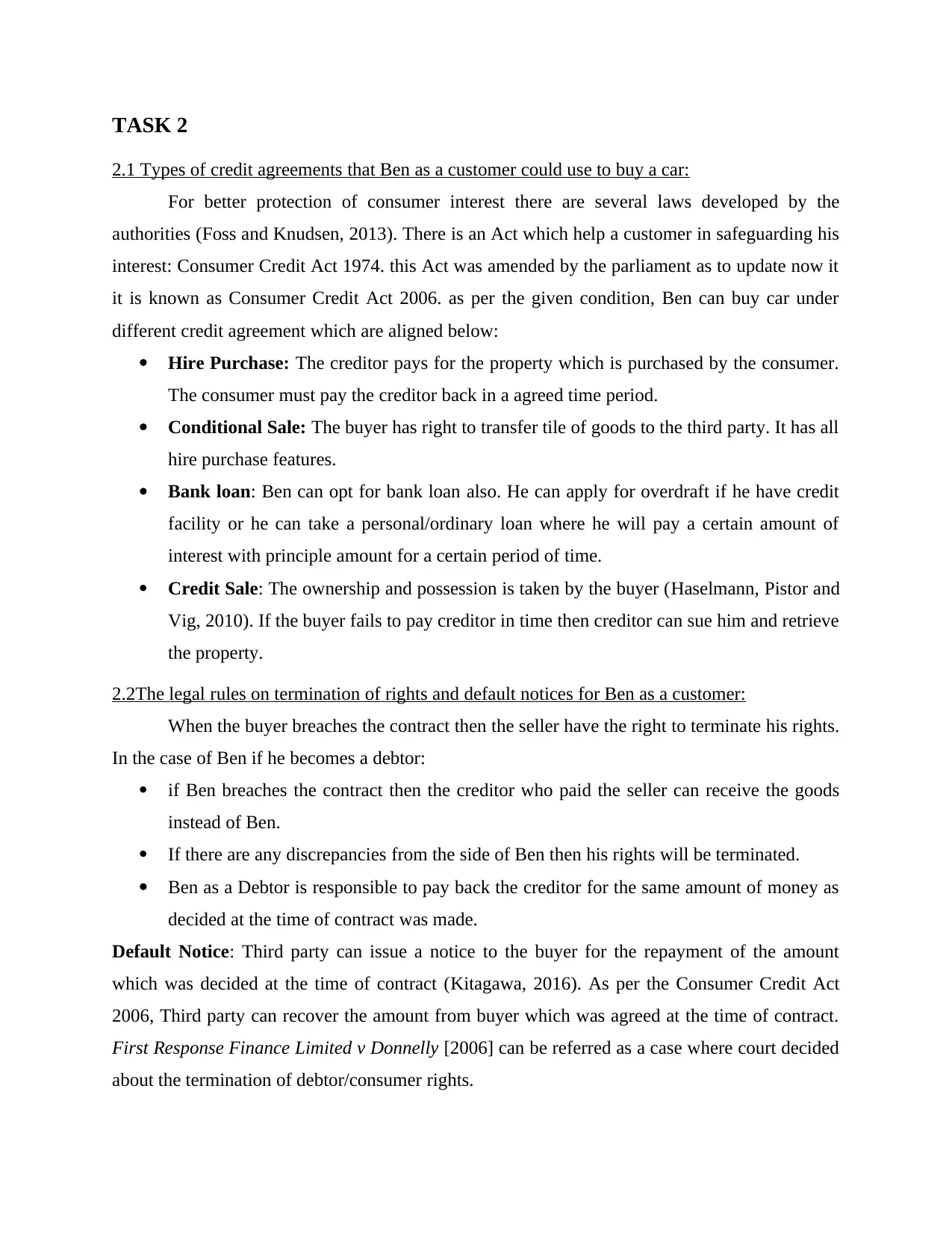
TASK 2
2.1 Types of credit agreements that Ben as a customer could use to buy a car:
For better protection of consumer interest there are several laws developed by the
authorities (Foss and Knudsen, 2013). There is an Act which help a customer in safeguarding his
interest: Consumer Credit Act 1974. this Act was amended by the parliament as to update now it
it is known as Consumer Credit Act 2006. as per the given condition, Ben can buy car under
different credit agreement which are aligned below:
Hire Purchase: The creditor pays for the property which is purchased by the consumer.
The consumer must pay the creditor back in a agreed time period.
Conditional Sale: The buyer has right to transfer tile of goods to the third party. It has all
hire purchase features.
Bank loan: Ben can opt for bank loan also. He can apply for overdraft if he have credit
facility or he can take a personal/ordinary loan where he will pay a certain amount of
interest with principle amount for a certain period of time.
Credit Sale: The ownership and possession is taken by the buyer (Haselmann, Pistor and
Vig, 2010). If the buyer fails to pay creditor in time then creditor can sue him and retrieve
the property.
2.2The legal rules on termination of rights and default notices for Ben as a customer:
When the buyer breaches the contract then the seller have the right to terminate his rights.
In the case of Ben if he becomes a debtor:
if Ben breaches the contract then the creditor who paid the seller can receive the goods
instead of Ben.
If there are any discrepancies from the side of Ben then his rights will be terminated.
Ben as a Debtor is responsible to pay back the creditor for the same amount of money as
decided at the time of contract was made.
Default Notice: Third party can issue a notice to the buyer for the repayment of the amount
which was decided at the time of contract (Kitagawa, 2016). As per the Consumer Credit Act
2006, Third party can recover the amount from buyer which was agreed at the time of contract.
First Response Finance Limited v Donnelly [2006] can be referred as a case where court decided
about the termination of debtor/consumer rights.
2.1 Types of credit agreements that Ben as a customer could use to buy a car:
For better protection of consumer interest there are several laws developed by the
authorities (Foss and Knudsen, 2013). There is an Act which help a customer in safeguarding his
interest: Consumer Credit Act 1974. this Act was amended by the parliament as to update now it
it is known as Consumer Credit Act 2006. as per the given condition, Ben can buy car under
different credit agreement which are aligned below:
Hire Purchase: The creditor pays for the property which is purchased by the consumer.
The consumer must pay the creditor back in a agreed time period.
Conditional Sale: The buyer has right to transfer tile of goods to the third party. It has all
hire purchase features.
Bank loan: Ben can opt for bank loan also. He can apply for overdraft if he have credit
facility or he can take a personal/ordinary loan where he will pay a certain amount of
interest with principle amount for a certain period of time.
Credit Sale: The ownership and possession is taken by the buyer (Haselmann, Pistor and
Vig, 2010). If the buyer fails to pay creditor in time then creditor can sue him and retrieve
the property.
2.2The legal rules on termination of rights and default notices for Ben as a customer:
When the buyer breaches the contract then the seller have the right to terminate his rights.
In the case of Ben if he becomes a debtor:
if Ben breaches the contract then the creditor who paid the seller can receive the goods
instead of Ben.
If there are any discrepancies from the side of Ben then his rights will be terminated.
Ben as a Debtor is responsible to pay back the creditor for the same amount of money as
decided at the time of contract was made.
Default Notice: Third party can issue a notice to the buyer for the repayment of the amount
which was decided at the time of contract (Kitagawa, 2016). As per the Consumer Credit Act
2006, Third party can recover the amount from buyer which was agreed at the time of contract.
First Response Finance Limited v Donnelly [2006] can be referred as a case where court decided
about the termination of debtor/consumer rights.
Paraphrase This Document
Need a fresh take? Get an instant paraphrase of this document with our AI Paraphraser
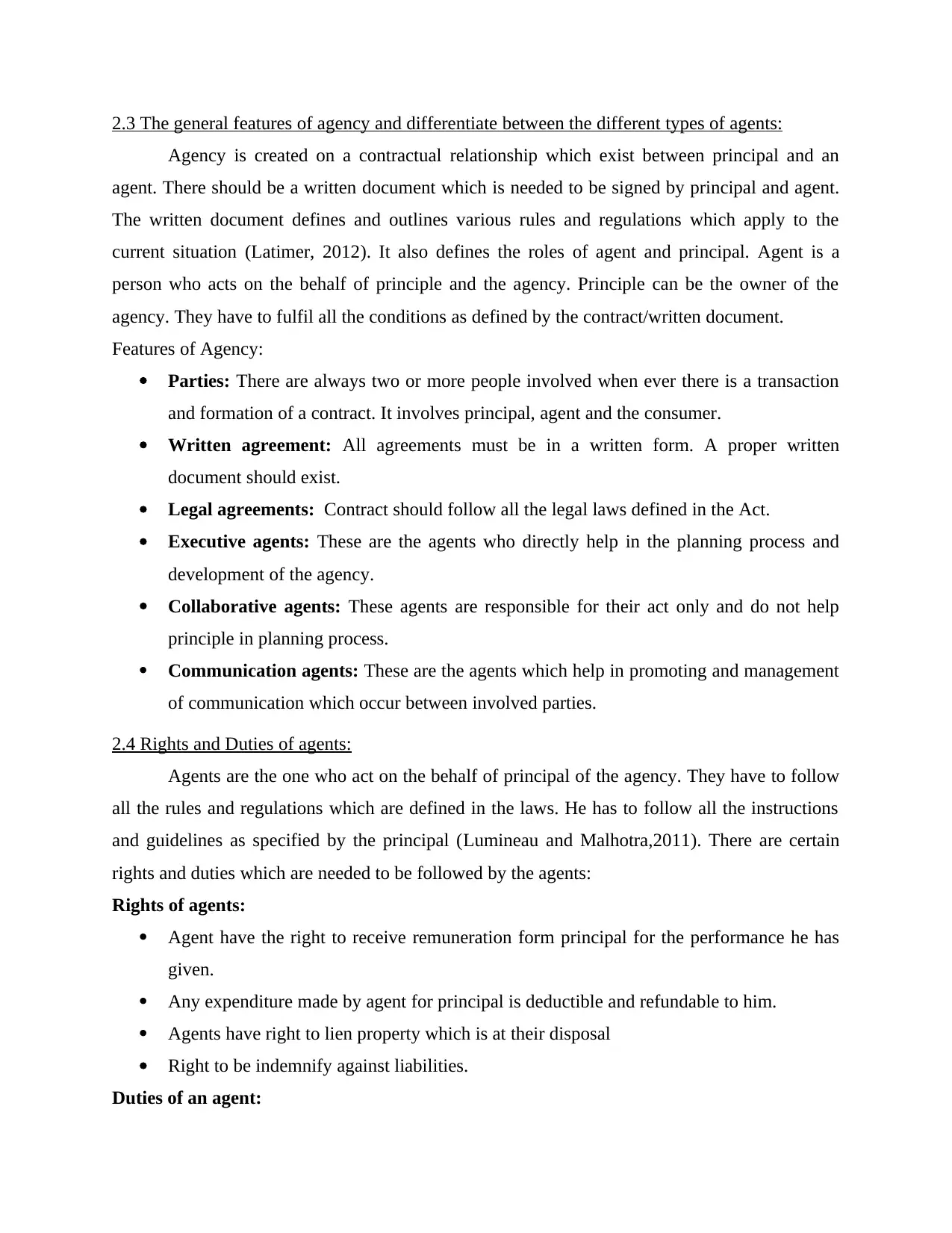
2.3 The general features of agency and differentiate between the different types of agents:
Agency is created on a contractual relationship which exist between principal and an
agent. There should be a written document which is needed to be signed by principal and agent.
The written document defines and outlines various rules and regulations which apply to the
current situation (Latimer, 2012). It also defines the roles of agent and principal. Agent is a
person who acts on the behalf of principle and the agency. Principle can be the owner of the
agency. They have to fulfil all the conditions as defined by the contract/written document.
Features of Agency:
Parties: There are always two or more people involved when ever there is a transaction
and formation of a contract. It involves principal, agent and the consumer.
Written agreement: All agreements must be in a written form. A proper written
document should exist.
Legal agreements: Contract should follow all the legal laws defined in the Act.
Executive agents: These are the agents who directly help in the planning process and
development of the agency.
Collaborative agents: These agents are responsible for their act only and do not help
principle in planning process.
Communication agents: These are the agents which help in promoting and management
of communication which occur between involved parties.
2.4 Rights and Duties of agents:
Agents are the one who act on the behalf of principal of the agency. They have to follow
all the rules and regulations which are defined in the laws. He has to follow all the instructions
and guidelines as specified by the principal (Lumineau and Malhotra,2011). There are certain
rights and duties which are needed to be followed by the agents:
Rights of agents:
Agent have the right to receive remuneration form principal for the performance he has
given.
Any expenditure made by agent for principal is deductible and refundable to him.
Agents have right to lien property which is at their disposal
Right to be indemnify against liabilities.
Duties of an agent:
Agency is created on a contractual relationship which exist between principal and an
agent. There should be a written document which is needed to be signed by principal and agent.
The written document defines and outlines various rules and regulations which apply to the
current situation (Latimer, 2012). It also defines the roles of agent and principal. Agent is a
person who acts on the behalf of principle and the agency. Principle can be the owner of the
agency. They have to fulfil all the conditions as defined by the contract/written document.
Features of Agency:
Parties: There are always two or more people involved when ever there is a transaction
and formation of a contract. It involves principal, agent and the consumer.
Written agreement: All agreements must be in a written form. A proper written
document should exist.
Legal agreements: Contract should follow all the legal laws defined in the Act.
Executive agents: These are the agents who directly help in the planning process and
development of the agency.
Collaborative agents: These agents are responsible for their act only and do not help
principle in planning process.
Communication agents: These are the agents which help in promoting and management
of communication which occur between involved parties.
2.4 Rights and Duties of agents:
Agents are the one who act on the behalf of principal of the agency. They have to follow
all the rules and regulations which are defined in the laws. He has to follow all the instructions
and guidelines as specified by the principal (Lumineau and Malhotra,2011). There are certain
rights and duties which are needed to be followed by the agents:
Rights of agents:
Agent have the right to receive remuneration form principal for the performance he has
given.
Any expenditure made by agent for principal is deductible and refundable to him.
Agents have right to lien property which is at their disposal
Right to be indemnify against liabilities.
Duties of an agent:

They have to follow the instruction of the principal.
They can only do business on the behalf of principal.
They have responsibility to main all the accounts and transactions which take place.
They have to maintain quality of work.
Agents are also responsible to communicate all necessary information in organisation and
also manage working relationship in the agency.
TASK 3
3.1 The monopolies and Anti competitive practice legislation in the UK:
Monopoly refers to the condition when a company holds majority of market share and
control in an industry. Also when the same company dominates the supply chain and production
of a specific product sold in an industry (Li and Freeman, 2015). The company have no major
competitor in the market hence it decides the prices of the product it sells. The United Kingdom
competition law has described various provisions which prohibits any monopolistic activity from
happening in market. The competition law has an impact from various European and British
laws. In United Kingdom there are two important statute which are implemented with
consistency at national level. Competition law was enacted in 1998 and Enterprise Act was
enacted in 2002. The Competition law 1998 of United Kingdom has stated Monopoly as an
activity when a company have over 25% of market share and is using its dominant power against
consumer and competitors. This situation usually arises when the company achieves higher rate
of growth or because of horizontal integration between two big companies.
Competition law 1998 and Enterprise Act 2002 have created two different entities which
monitor and regulate market as to keep any anti competitive activity from occurring (Mann and
Roberts, 2011). Competition Commission and Office of fair trade are those two entities which
monitor and regulate the market. Activities which can harm competitors and consumers are
prohibits. Activities such as- Dumping, gouging, repression of cartel, predatory pricing, free
trading, etc.
3.2 The Role of Competition commission in UK:
The main purpose behind the making of Competition law 1998 was to monitor and
regulate any merger, joint venture, acquisition or another monopolistic activity (Nichols, 2012).
They can only do business on the behalf of principal.
They have responsibility to main all the accounts and transactions which take place.
They have to maintain quality of work.
Agents are also responsible to communicate all necessary information in organisation and
also manage working relationship in the agency.
TASK 3
3.1 The monopolies and Anti competitive practice legislation in the UK:
Monopoly refers to the condition when a company holds majority of market share and
control in an industry. Also when the same company dominates the supply chain and production
of a specific product sold in an industry (Li and Freeman, 2015). The company have no major
competitor in the market hence it decides the prices of the product it sells. The United Kingdom
competition law has described various provisions which prohibits any monopolistic activity from
happening in market. The competition law has an impact from various European and British
laws. In United Kingdom there are two important statute which are implemented with
consistency at national level. Competition law was enacted in 1998 and Enterprise Act was
enacted in 2002. The Competition law 1998 of United Kingdom has stated Monopoly as an
activity when a company have over 25% of market share and is using its dominant power against
consumer and competitors. This situation usually arises when the company achieves higher rate
of growth or because of horizontal integration between two big companies.
Competition law 1998 and Enterprise Act 2002 have created two different entities which
monitor and regulate market as to keep any anti competitive activity from occurring (Mann and
Roberts, 2011). Competition Commission and Office of fair trade are those two entities which
monitor and regulate the market. Activities which can harm competitors and consumers are
prohibits. Activities such as- Dumping, gouging, repression of cartel, predatory pricing, free
trading, etc.
3.2 The Role of Competition commission in UK:
The main purpose behind the making of Competition law 1998 was to monitor and
regulate any merger, joint venture, acquisition or another monopolistic activity (Nichols, 2012).

Case in this regard can be Tesco-WM Morrison Supermarkets, 2005. Tesco was meging
Morrisons which was found against Phase1 of merger and hence they were not allowed to merge.
The competition law 1998 replace the Monopolies and Mergers commission. The
competition commission gets the cases referred from the Office of Fair Trade for making
recommendation. Competition commission has to recommend and suggest what measures office
of fair trade has to take against the parties involved in the act of Monopolies. The Competition
commission has to analyse the whole case and if they find any issues in the process, they will
recommend office of fair trade to take certain actions against the companies.
Office of Fair Trade have all the powers of taking actions against the companies involved
in an act of monopoly. It penalises the defaulters (Passera and Haapio, 2011). Anyone can refer
the case to the office of fair trade. Competition Commission and Office of Fair Trade keep track
of all the activities which are occurring in the market between all the business. Any acquisition,
merger, joint venture and divestment has to get approved by the commissions. They keep a tract
of following activity while analysing of a case:
New market share of entity
R&D capabilities of the new firm
New entity market control
Production power
Influence
Competition commission and Office of fair Trade are made in a way that even a common
citizen of the country can refer a case which he thinks violates the law of land. Enterprise Act
2002 has given more power to the Competition commission (Percival and et. al., 2013). It has
added new provision of power to the commission which has enabled them in dealing with the
cases. Basically Competition commission did not had any enforcing power with it but after
Enterprise Act came into existence it has received enforcing powers too. Now they actually
dictate office of fair trade about the possible provision which can be used against the companies
engaged in act of monopoly.
3.3 Dominant Positions within EU:
Dominant positions are achieved when the company Becomes a major force in the
market. If a company controls over 40% of market share and it is exploiting the competitors and
consumers with its policies and pricing then it will be considered as a dominant power (Robson,
Morrisons which was found against Phase1 of merger and hence they were not allowed to merge.
The competition law 1998 replace the Monopolies and Mergers commission. The
competition commission gets the cases referred from the Office of Fair Trade for making
recommendation. Competition commission has to recommend and suggest what measures office
of fair trade has to take against the parties involved in the act of Monopolies. The Competition
commission has to analyse the whole case and if they find any issues in the process, they will
recommend office of fair trade to take certain actions against the companies.
Office of Fair Trade have all the powers of taking actions against the companies involved
in an act of monopoly. It penalises the defaulters (Passera and Haapio, 2011). Anyone can refer
the case to the office of fair trade. Competition Commission and Office of Fair Trade keep track
of all the activities which are occurring in the market between all the business. Any acquisition,
merger, joint venture and divestment has to get approved by the commissions. They keep a tract
of following activity while analysing of a case:
New market share of entity
R&D capabilities of the new firm
New entity market control
Production power
Influence
Competition commission and Office of fair Trade are made in a way that even a common
citizen of the country can refer a case which he thinks violates the law of land. Enterprise Act
2002 has given more power to the Competition commission (Percival and et. al., 2013). It has
added new provision of power to the commission which has enabled them in dealing with the
cases. Basically Competition commission did not had any enforcing power with it but after
Enterprise Act came into existence it has received enforcing powers too. Now they actually
dictate office of fair trade about the possible provision which can be used against the companies
engaged in act of monopoly.
3.3 Dominant Positions within EU:
Dominant positions are achieved when the company Becomes a major force in the
market. If a company controls over 40% of market share and it is exploiting the competitors and
consumers with its policies and pricing then it will be considered as a dominant power (Robson,
Secure Best Marks with AI Grader
Need help grading? Try our AI Grader for instant feedback on your assignments.
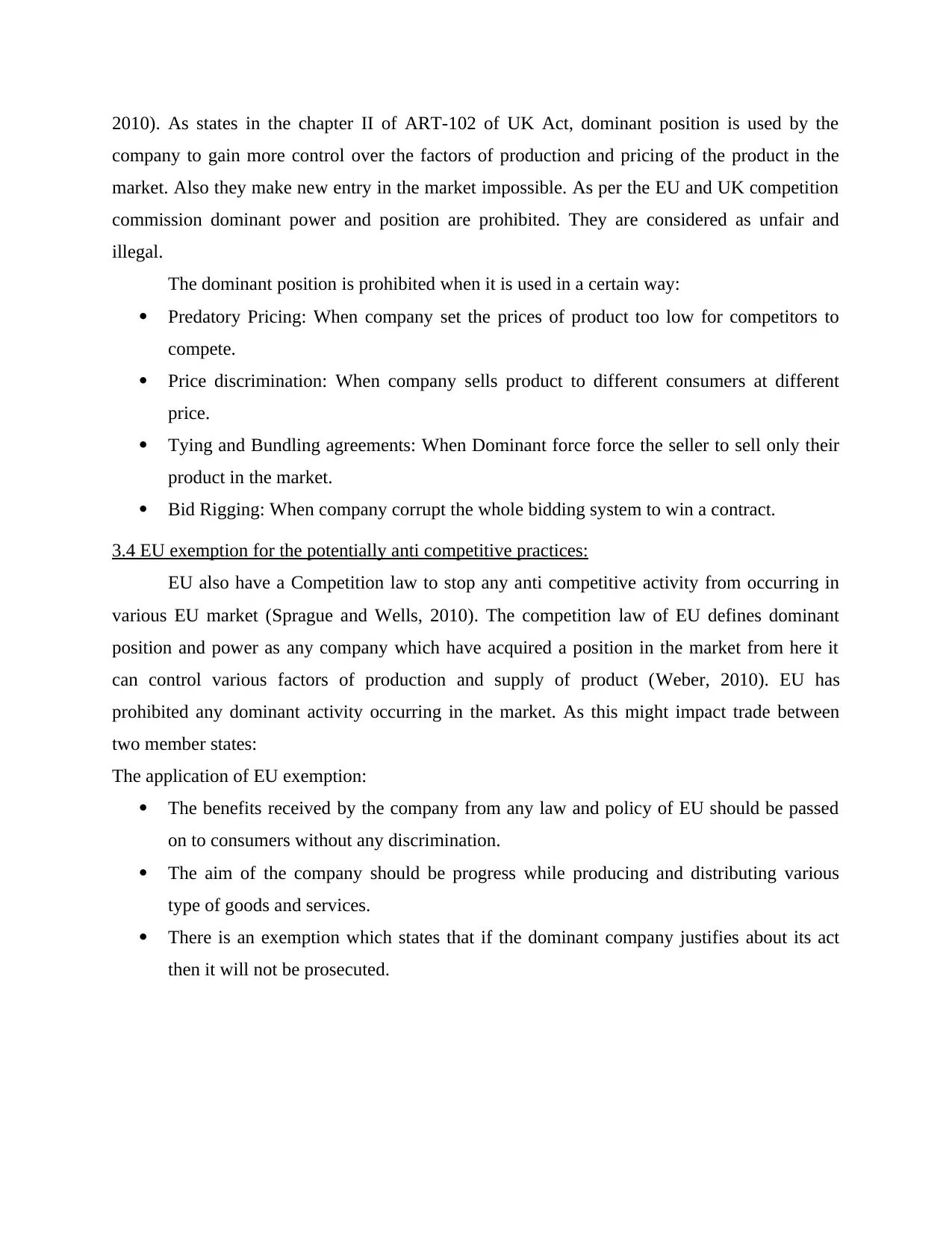
2010). As states in the chapter II of ART-102 of UK Act, dominant position is used by the
company to gain more control over the factors of production and pricing of the product in the
market. Also they make new entry in the market impossible. As per the EU and UK competition
commission dominant power and position are prohibited. They are considered as unfair and
illegal.
The dominant position is prohibited when it is used in a certain way:
Predatory Pricing: When company set the prices of product too low for competitors to
compete.
Price discrimination: When company sells product to different consumers at different
price.
Tying and Bundling agreements: When Dominant force force the seller to sell only their
product in the market.
Bid Rigging: When company corrupt the whole bidding system to win a contract.
3.4 EU exemption for the potentially anti competitive practices:
EU also have a Competition law to stop any anti competitive activity from occurring in
various EU market (Sprague and Wells, 2010). The competition law of EU defines dominant
position and power as any company which have acquired a position in the market from here it
can control various factors of production and supply of product (Weber, 2010). EU has
prohibited any dominant activity occurring in the market. As this might impact trade between
two member states:
The application of EU exemption:
The benefits received by the company from any law and policy of EU should be passed
on to consumers without any discrimination.
The aim of the company should be progress while producing and distributing various
type of goods and services.
There is an exemption which states that if the dominant company justifies about its act
then it will not be prosecuted.
company to gain more control over the factors of production and pricing of the product in the
market. Also they make new entry in the market impossible. As per the EU and UK competition
commission dominant power and position are prohibited. They are considered as unfair and
illegal.
The dominant position is prohibited when it is used in a certain way:
Predatory Pricing: When company set the prices of product too low for competitors to
compete.
Price discrimination: When company sells product to different consumers at different
price.
Tying and Bundling agreements: When Dominant force force the seller to sell only their
product in the market.
Bid Rigging: When company corrupt the whole bidding system to win a contract.
3.4 EU exemption for the potentially anti competitive practices:
EU also have a Competition law to stop any anti competitive activity from occurring in
various EU market (Sprague and Wells, 2010). The competition law of EU defines dominant
position and power as any company which have acquired a position in the market from here it
can control various factors of production and supply of product (Weber, 2010). EU has
prohibited any dominant activity occurring in the market. As this might impact trade between
two member states:
The application of EU exemption:
The benefits received by the company from any law and policy of EU should be passed
on to consumers without any discrimination.
The aim of the company should be progress while producing and distributing various
type of goods and services.
There is an exemption which states that if the dominant company justifies about its act
then it will not be prosecuted.
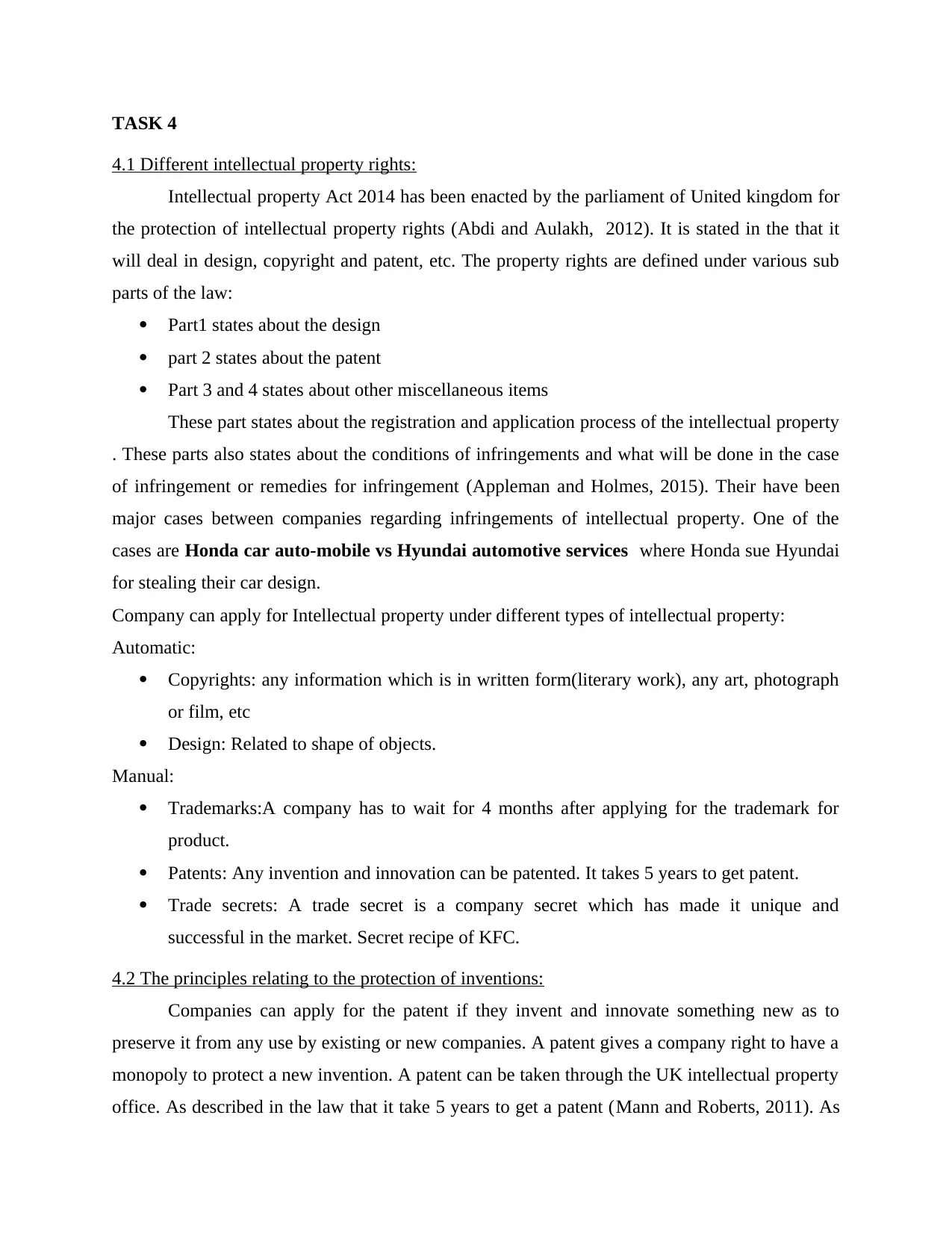
TASK 4
4.1 Different intellectual property rights:
Intellectual property Act 2014 has been enacted by the parliament of United kingdom for
the protection of intellectual property rights (Abdi and Aulakh, 2012). It is stated in the that it
will deal in design, copyright and patent, etc. The property rights are defined under various sub
parts of the law:
Part1 states about the design
part 2 states about the patent
Part 3 and 4 states about other miscellaneous items
These part states about the registration and application process of the intellectual property
. These parts also states about the conditions of infringements and what will be done in the case
of infringement or remedies for infringement (Appleman and Holmes, 2015). Their have been
major cases between companies regarding infringements of intellectual property. One of the
cases are Honda car auto-mobile vs Hyundai automotive services where Honda sue Hyundai
for stealing their car design.
Company can apply for Intellectual property under different types of intellectual property:
Automatic:
Copyrights: any information which is in written form(literary work), any art, photograph
or film, etc
Design: Related to shape of objects.
Manual:
Trademarks:A company has to wait for 4 months after applying for the trademark for
product.
Patents: Any invention and innovation can be patented. It takes 5 years to get patent.
Trade secrets: A trade secret is a company secret which has made it unique and
successful in the market. Secret recipe of KFC.
4.2 The principles relating to the protection of inventions:
Companies can apply for the patent if they invent and innovate something new as to
preserve it from any use by existing or new companies. A patent gives a company right to have a
monopoly to protect a new invention. A patent can be taken through the UK intellectual property
office. As described in the law that it take 5 years to get a patent (Mann and Roberts, 2011). As
4.1 Different intellectual property rights:
Intellectual property Act 2014 has been enacted by the parliament of United kingdom for
the protection of intellectual property rights (Abdi and Aulakh, 2012). It is stated in the that it
will deal in design, copyright and patent, etc. The property rights are defined under various sub
parts of the law:
Part1 states about the design
part 2 states about the patent
Part 3 and 4 states about other miscellaneous items
These part states about the registration and application process of the intellectual property
. These parts also states about the conditions of infringements and what will be done in the case
of infringement or remedies for infringement (Appleman and Holmes, 2015). Their have been
major cases between companies regarding infringements of intellectual property. One of the
cases are Honda car auto-mobile vs Hyundai automotive services where Honda sue Hyundai
for stealing their car design.
Company can apply for Intellectual property under different types of intellectual property:
Automatic:
Copyrights: any information which is in written form(literary work), any art, photograph
or film, etc
Design: Related to shape of objects.
Manual:
Trademarks:A company has to wait for 4 months after applying for the trademark for
product.
Patents: Any invention and innovation can be patented. It takes 5 years to get patent.
Trade secrets: A trade secret is a company secret which has made it unique and
successful in the market. Secret recipe of KFC.
4.2 The principles relating to the protection of inventions:
Companies can apply for the patent if they invent and innovate something new as to
preserve it from any use by existing or new companies. A patent gives a company right to have a
monopoly to protect a new invention. A patent can be taken through the UK intellectual property
office. As described in the law that it take 5 years to get a patent (Mann and Roberts, 2011). As
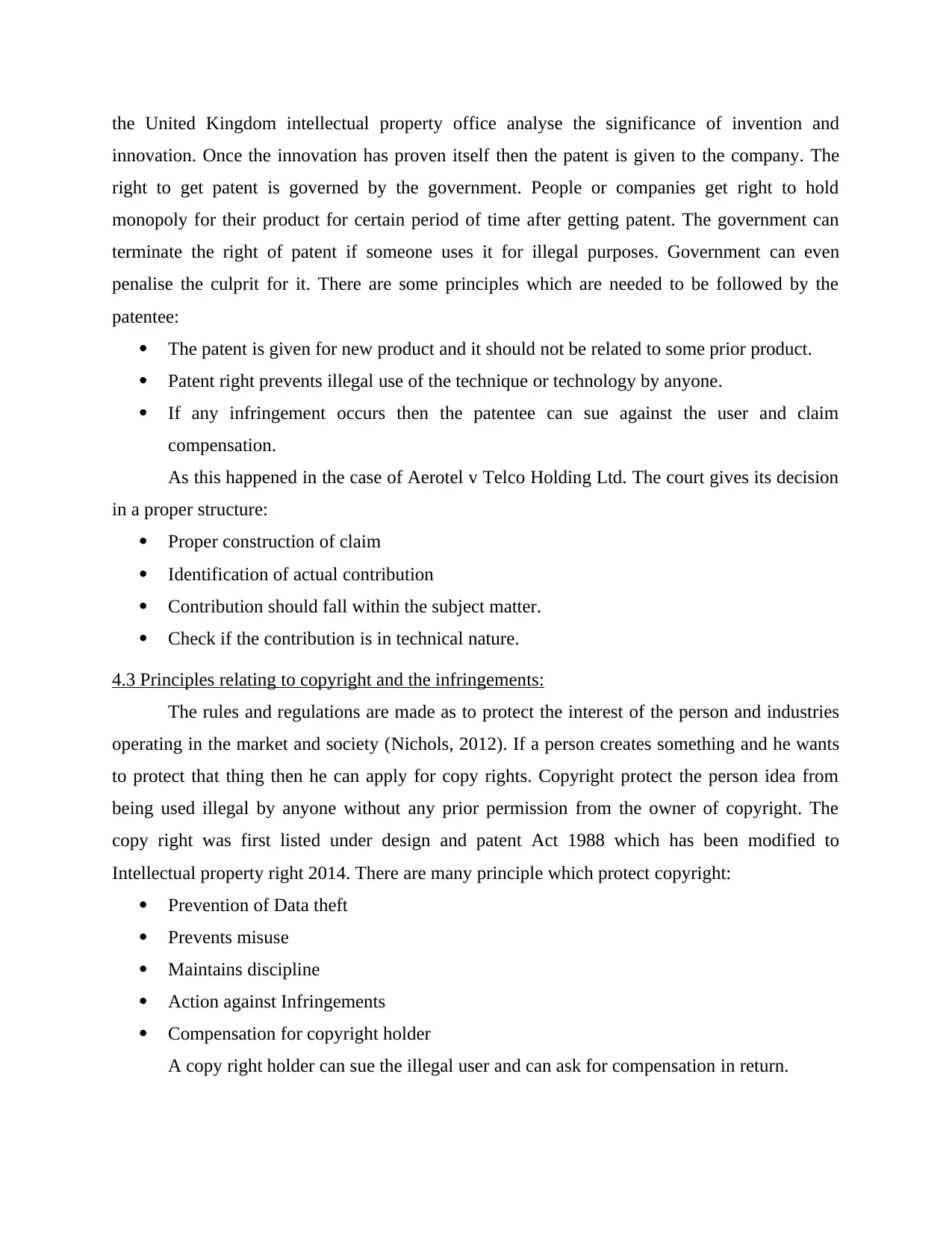
the United Kingdom intellectual property office analyse the significance of invention and
innovation. Once the innovation has proven itself then the patent is given to the company. The
right to get patent is governed by the government. People or companies get right to hold
monopoly for their product for certain period of time after getting patent. The government can
terminate the right of patent if someone uses it for illegal purposes. Government can even
penalise the culprit for it. There are some principles which are needed to be followed by the
patentee:
The patent is given for new product and it should not be related to some prior product.
Patent right prevents illegal use of the technique or technology by anyone.
If any infringement occurs then the patentee can sue against the user and claim
compensation.
As this happened in the case of Aerotel v Telco Holding Ltd. The court gives its decision
in a proper structure:
Proper construction of claim
Identification of actual contribution
Contribution should fall within the subject matter.
Check if the contribution is in technical nature.
4.3 Principles relating to copyright and the infringements:
The rules and regulations are made as to protect the interest of the person and industries
operating in the market and society (Nichols, 2012). If a person creates something and he wants
to protect that thing then he can apply for copy rights. Copyright protect the person idea from
being used illegal by anyone without any prior permission from the owner of copyright. The
copy right was first listed under design and patent Act 1988 which has been modified to
Intellectual property right 2014. There are many principle which protect copyright:
Prevention of Data theft
Prevents misuse
Maintains discipline
Action against Infringements
Compensation for copyright holder
A copy right holder can sue the illegal user and can ask for compensation in return.
innovation. Once the innovation has proven itself then the patent is given to the company. The
right to get patent is governed by the government. People or companies get right to hold
monopoly for their product for certain period of time after getting patent. The government can
terminate the right of patent if someone uses it for illegal purposes. Government can even
penalise the culprit for it. There are some principles which are needed to be followed by the
patentee:
The patent is given for new product and it should not be related to some prior product.
Patent right prevents illegal use of the technique or technology by anyone.
If any infringement occurs then the patentee can sue against the user and claim
compensation.
As this happened in the case of Aerotel v Telco Holding Ltd. The court gives its decision
in a proper structure:
Proper construction of claim
Identification of actual contribution
Contribution should fall within the subject matter.
Check if the contribution is in technical nature.
4.3 Principles relating to copyright and the infringements:
The rules and regulations are made as to protect the interest of the person and industries
operating in the market and society (Nichols, 2012). If a person creates something and he wants
to protect that thing then he can apply for copy rights. Copyright protect the person idea from
being used illegal by anyone without any prior permission from the owner of copyright. The
copy right was first listed under design and patent Act 1988 which has been modified to
Intellectual property right 2014. There are many principle which protect copyright:
Prevention of Data theft
Prevents misuse
Maintains discipline
Action against Infringements
Compensation for copyright holder
A copy right holder can sue the illegal user and can ask for compensation in return.
Paraphrase This Document
Need a fresh take? Get an instant paraphrase of this document with our AI Paraphraser
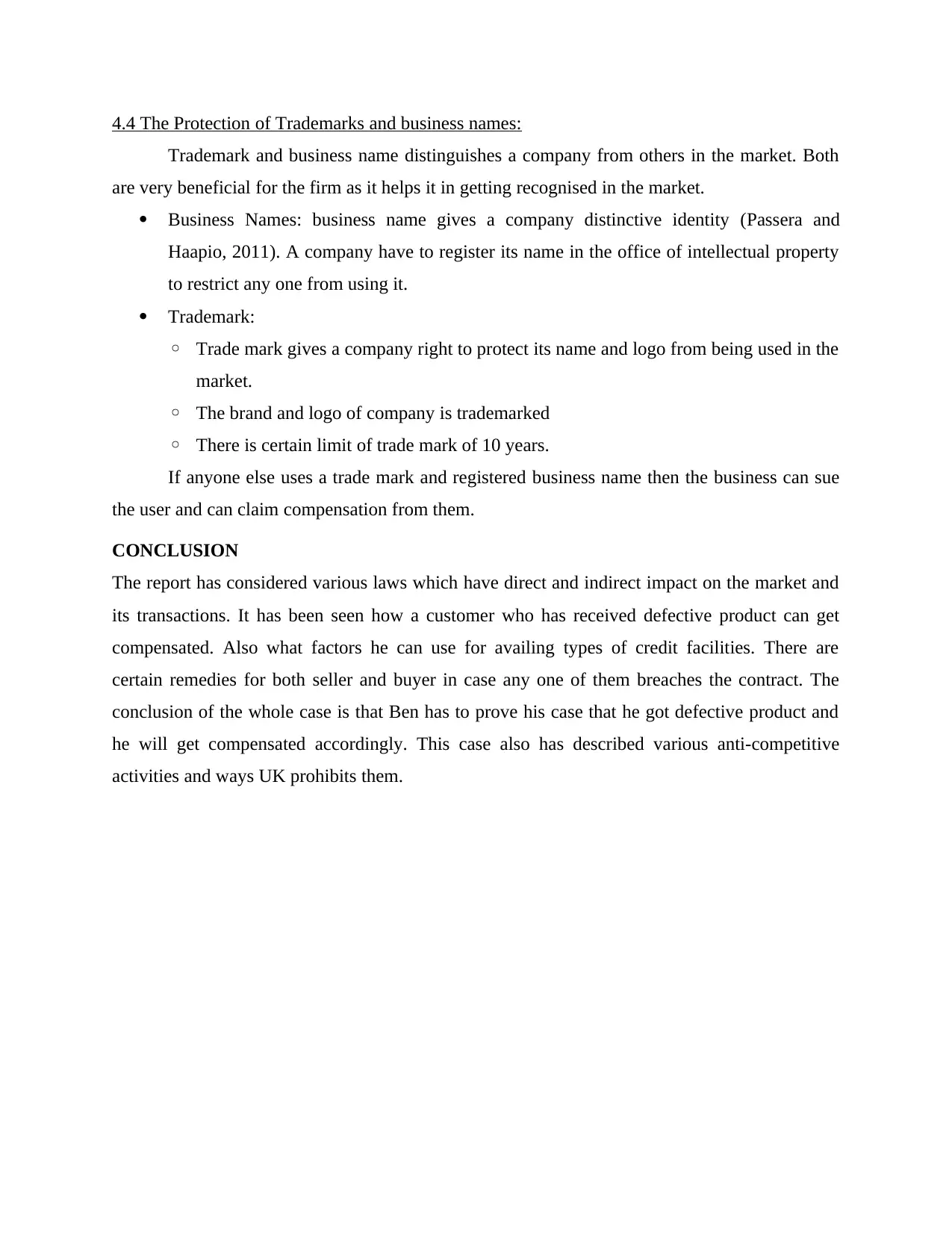
4.4 The Protection of Trademarks and business names:
Trademark and business name distinguishes a company from others in the market. Both
are very beneficial for the firm as it helps it in getting recognised in the market.
Business Names: business name gives a company distinctive identity (Passera and
Haapio, 2011). A company have to register its name in the office of intellectual property
to restrict any one from using it.
Trademark:
◦ Trade mark gives a company right to protect its name and logo from being used in the
market.
◦ The brand and logo of company is trademarked
◦ There is certain limit of trade mark of 10 years.
If anyone else uses a trade mark and registered business name then the business can sue
the user and can claim compensation from them.
CONCLUSION
The report has considered various laws which have direct and indirect impact on the market and
its transactions. It has been seen how a customer who has received defective product can get
compensated. Also what factors he can use for availing types of credit facilities. There are
certain remedies for both seller and buyer in case any one of them breaches the contract. The
conclusion of the whole case is that Ben has to prove his case that he got defective product and
he will get compensated accordingly. This case also has described various anti-competitive
activities and ways UK prohibits them.
Trademark and business name distinguishes a company from others in the market. Both
are very beneficial for the firm as it helps it in getting recognised in the market.
Business Names: business name gives a company distinctive identity (Passera and
Haapio, 2011). A company have to register its name in the office of intellectual property
to restrict any one from using it.
Trademark:
◦ Trade mark gives a company right to protect its name and logo from being used in the
market.
◦ The brand and logo of company is trademarked
◦ There is certain limit of trade mark of 10 years.
If anyone else uses a trade mark and registered business name then the business can sue
the user and can claim compensation from them.
CONCLUSION
The report has considered various laws which have direct and indirect impact on the market and
its transactions. It has been seen how a customer who has received defective product can get
compensated. Also what factors he can use for availing types of credit facilities. There are
certain remedies for both seller and buyer in case any one of them breaches the contract. The
conclusion of the whole case is that Ben has to prove his case that he got defective product and
he will get compensated accordingly. This case also has described various anti-competitive
activities and ways UK prohibits them.
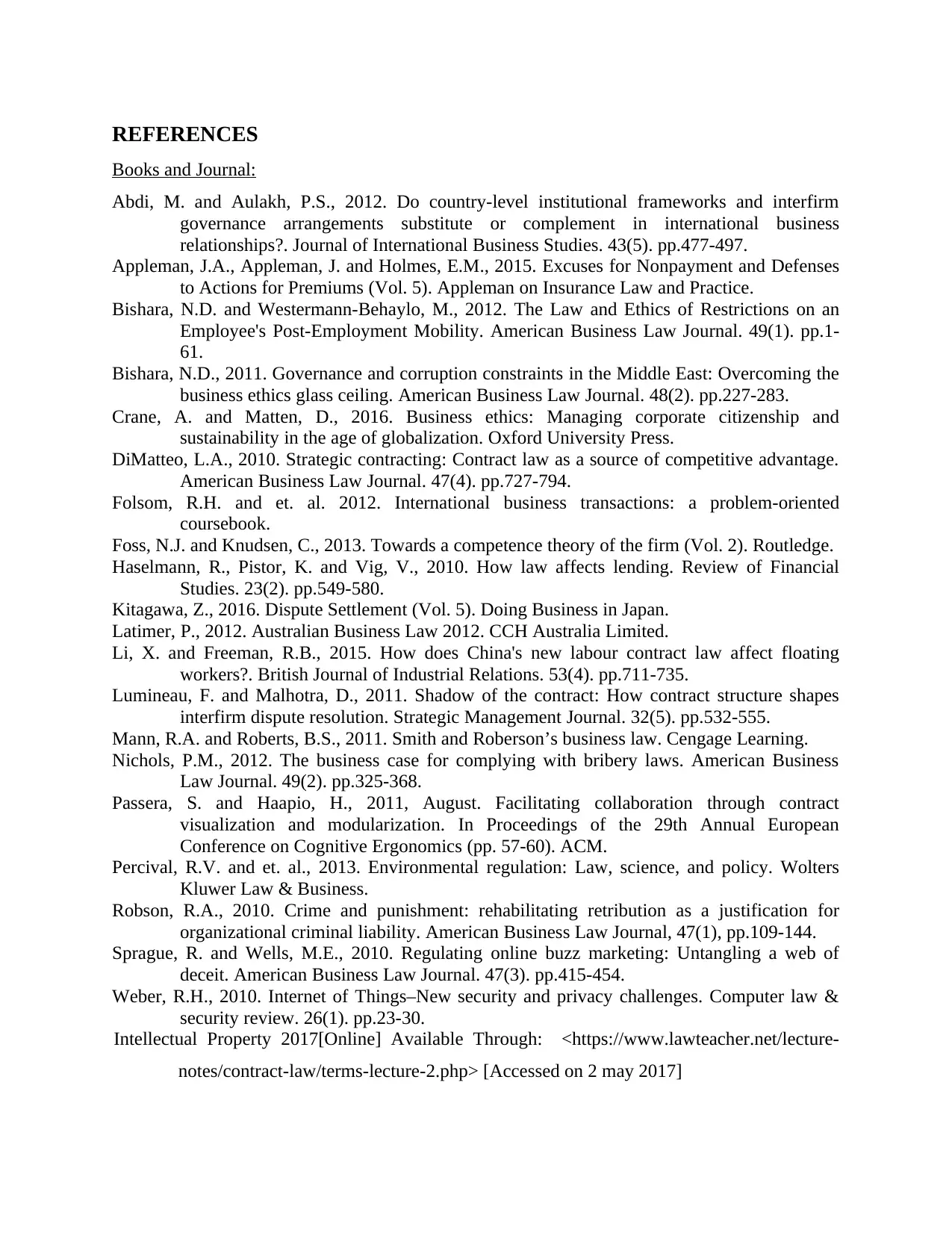
REFERENCES
Books and Journal:
Abdi, M. and Aulakh, P.S., 2012. Do country-level institutional frameworks and interfirm
governance arrangements substitute or complement in international business
relationships?. Journal of International Business Studies. 43(5). pp.477-497.
Appleman, J.A., Appleman, J. and Holmes, E.M., 2015. Excuses for Nonpayment and Defenses
to Actions for Premiums (Vol. 5). Appleman on Insurance Law and Practice.
Bishara, N.D. and Westermann‐Behaylo, M., 2012. The Law and Ethics of Restrictions on an
Employee's Post‐Employment Mobility. American Business Law Journal. 49(1). pp.1-
61.
Bishara, N.D., 2011. Governance and corruption constraints in the Middle East: Overcoming the
business ethics glass ceiling. American Business Law Journal. 48(2). pp.227-283.
Crane, A. and Matten, D., 2016. Business ethics: Managing corporate citizenship and
sustainability in the age of globalization. Oxford University Press.
DiMatteo, L.A., 2010. Strategic contracting: Contract law as a source of competitive advantage.
American Business Law Journal. 47(4). pp.727-794.
Folsom, R.H. and et. al. 2012. International business transactions: a problem-oriented
coursebook.
Foss, N.J. and Knudsen, C., 2013. Towards a competence theory of the firm (Vol. 2). Routledge.
Haselmann, R., Pistor, K. and Vig, V., 2010. How law affects lending. Review of Financial
Studies. 23(2). pp.549-580.
Kitagawa, Z., 2016. Dispute Settlement (Vol. 5). Doing Business in Japan.
Latimer, P., 2012. Australian Business Law 2012. CCH Australia Limited.
Li, X. and Freeman, R.B., 2015. How does China's new labour contract law affect floating
workers?. British Journal of Industrial Relations. 53(4). pp.711-735.
Lumineau, F. and Malhotra, D., 2011. Shadow of the contract: How contract structure shapes
interfirm dispute resolution. Strategic Management Journal. 32(5). pp.532-555.
Mann, R.A. and Roberts, B.S., 2011. Smith and Roberson’s business law. Cengage Learning.
Nichols, P.M., 2012. The business case for complying with bribery laws. American Business
Law Journal. 49(2). pp.325-368.
Passera, S. and Haapio, H., 2011, August. Facilitating collaboration through contract
visualization and modularization. In Proceedings of the 29th Annual European
Conference on Cognitive Ergonomics (pp. 57-60). ACM.
Percival, R.V. and et. al., 2013. Environmental regulation: Law, science, and policy. Wolters
Kluwer Law & Business.
Robson, R.A., 2010. Crime and punishment: rehabilitating retribution as a justification for
organizational criminal liability. American Business Law Journal, 47(1), pp.109-144.
Sprague, R. and Wells, M.E., 2010. Regulating online buzz marketing: Untangling a web of
deceit. American Business Law Journal. 47(3). pp.415-454.
Weber, R.H., 2010. Internet of Things–New security and privacy challenges. Computer law &
security review. 26(1). pp.23-30.
Intellectual Property 2017[Online] Available Through: <https://www.lawteacher.net/lecture-
notes/contract-law/terms-lecture-2.php> [Accessed on 2 may 2017]
Books and Journal:
Abdi, M. and Aulakh, P.S., 2012. Do country-level institutional frameworks and interfirm
governance arrangements substitute or complement in international business
relationships?. Journal of International Business Studies. 43(5). pp.477-497.
Appleman, J.A., Appleman, J. and Holmes, E.M., 2015. Excuses for Nonpayment and Defenses
to Actions for Premiums (Vol. 5). Appleman on Insurance Law and Practice.
Bishara, N.D. and Westermann‐Behaylo, M., 2012. The Law and Ethics of Restrictions on an
Employee's Post‐Employment Mobility. American Business Law Journal. 49(1). pp.1-
61.
Bishara, N.D., 2011. Governance and corruption constraints in the Middle East: Overcoming the
business ethics glass ceiling. American Business Law Journal. 48(2). pp.227-283.
Crane, A. and Matten, D., 2016. Business ethics: Managing corporate citizenship and
sustainability in the age of globalization. Oxford University Press.
DiMatteo, L.A., 2010. Strategic contracting: Contract law as a source of competitive advantage.
American Business Law Journal. 47(4). pp.727-794.
Folsom, R.H. and et. al. 2012. International business transactions: a problem-oriented
coursebook.
Foss, N.J. and Knudsen, C., 2013. Towards a competence theory of the firm (Vol. 2). Routledge.
Haselmann, R., Pistor, K. and Vig, V., 2010. How law affects lending. Review of Financial
Studies. 23(2). pp.549-580.
Kitagawa, Z., 2016. Dispute Settlement (Vol. 5). Doing Business in Japan.
Latimer, P., 2012. Australian Business Law 2012. CCH Australia Limited.
Li, X. and Freeman, R.B., 2015. How does China's new labour contract law affect floating
workers?. British Journal of Industrial Relations. 53(4). pp.711-735.
Lumineau, F. and Malhotra, D., 2011. Shadow of the contract: How contract structure shapes
interfirm dispute resolution. Strategic Management Journal. 32(5). pp.532-555.
Mann, R.A. and Roberts, B.S., 2011. Smith and Roberson’s business law. Cengage Learning.
Nichols, P.M., 2012. The business case for complying with bribery laws. American Business
Law Journal. 49(2). pp.325-368.
Passera, S. and Haapio, H., 2011, August. Facilitating collaboration through contract
visualization and modularization. In Proceedings of the 29th Annual European
Conference on Cognitive Ergonomics (pp. 57-60). ACM.
Percival, R.V. and et. al., 2013. Environmental regulation: Law, science, and policy. Wolters
Kluwer Law & Business.
Robson, R.A., 2010. Crime and punishment: rehabilitating retribution as a justification for
organizational criminal liability. American Business Law Journal, 47(1), pp.109-144.
Sprague, R. and Wells, M.E., 2010. Regulating online buzz marketing: Untangling a web of
deceit. American Business Law Journal. 47(3). pp.415-454.
Weber, R.H., 2010. Internet of Things–New security and privacy challenges. Computer law &
security review. 26(1). pp.23-30.
Intellectual Property 2017[Online] Available Through: <https://www.lawteacher.net/lecture-
notes/contract-law/terms-lecture-2.php> [Accessed on 2 may 2017]

Summary of Intellectual property rights 2017[Online] Availaible Through:
<https://www.copyrightservice.co.uk/copyright/intellectual_property> [Accessed on 2
may 2017]
<https://www.copyrightservice.co.uk/copyright/intellectual_property> [Accessed on 2
may 2017]
1 out of 16
Related Documents
Your All-in-One AI-Powered Toolkit for Academic Success.
+13062052269
info@desklib.com
Available 24*7 on WhatsApp / Email
![[object Object]](/_next/static/media/star-bottom.7253800d.svg)
Unlock your academic potential
© 2024 | Zucol Services PVT LTD | All rights reserved.




